CFO Stories
Collectively celebrating Ozarks good
A look back at the 2023 Smithsonian Folklife Festival’s Ozarks program gives chance to see common goals

A look back at the 2023 Smithsonian Folklife Festival’s Ozarks program gives chance to see common goals
For those of us who love the Ozarks, it’s likely we have common reasons for why we feel the region is unique. Its natural beauty, perhaps, or its people. Each of us who call ourselves Ozarkers have ways to define the descriptor and what it means to us.
As an Ozarks documentarian and founder of Ozarks Alive, those thoughts and more are often on my mind when I think about regional identity, but they evolved in a new way while I was part of the curatorial team for the Smithsonian Folklife Festival’s Ozarks program. For more than two years, representatives from the Smithsonian and other regional partners met regularly to plan the festival, which ran from late June through early July in Washington, D.C.
It’s part of a festival that began in 1967, and showcases different countries, states, regions and other themes each year. While Arkansas was featured in 1970, this festival was the first time the Ozarks region was highlighted in this way.

Over the course of two weeks, about 70 participants — showcasing local culture like foodways, music, dance and crafts — to the National Mall.
There were crafters and musicians, the latter bringing traditions from old-time folk tunes to The Ozark Mountain Daredevils’ popular hits.
There were people whose families have lived in the Ozarks for generations alongside others who arrived far more recently, such as the Marshallese, whose greater Ozarks presence is now one of the largest communities outside of the Marshall Islands.
It was amazing to be part of this experience, one with built-in awe as you stood near the program’s space and saw the Washington Monument on one side and the U.S. Capitol on the other. While in D.C., I even had the chance to visit with Dean Thompson, chair of the CFO’s Board of Directors, who visited the festival with his family.
Even as days fade, I am confident that moments made on the Mall will continue long beyond the time they took to happen — both for folks who visited, but also for people from the Ozarks, who had the chance to have extended visit with others hyper-invested in the region.
In a lot of ways, it’s surreal to realize the festival is over.

Yet as I reflect on the experience, I know it’s not really finished: I believe it will create a lasting impact on how we see the region, how we celebrate its culture, and the energy that tells its story — and create a better tomorrow.
I also see similarities between the festival and what many of us try to do at home: Celebrate and recognize unique aspects of the region. At times, that means honoring its history; at others, acknowledging what things look like today, and how we can do better.
Those are things we do every day at the CFO, too. As writer in residence for the CFO, it’s my privilege to travel throughout the region and report on the unique, innovative and defining ways our region works to celebrate its heritage today, but also make it a more accessible place for everyone to live and succeed.

Because while we think of distilling and quilting and the music picking being inherently Ozarks — and they are skills of our regional heritage — there are many other traditions that are part of our contemporary regional story, too.
I see it through things like grants from the CFO’s Diversity, Equity & Inclusion Fund, one of which recently helped fund restoration of the Sadie Brown Cemetery near the edge of West Plains. Another example came last year, when high school students at Springfield’s urban Central and rural Fordland did an “exchange” program to learn more about each other’s experiences.
It’s also seen through the celebration of public spaces that define our region’s history, like grants from the Coover Charitable Foundation that supported work at legacy Ozarks sites like Hammond Mill Camp and the Eleven Point Community Center. It’s through the Ozark Teacher Corps program, which helps local educators invest time in rural districts to help promote a sense of place.
And it all goes back to sharing and preserving the unique culture of our Ozarks, a region that can both celebrate its past while looking to its future. Not because it’s more special than other places, but because it’s us — and that’s worth celebrating.